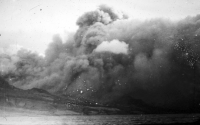Deadly clouds and volcanic flows
- Date
- 17 Jul 2018
- Start time
- 7:30 PM
- Venue
- Tempest Anderson Hall
- Speaker
- Dr Rebecca Williams, University of Hull

Deadly clouds and volcanic flows
Dr Rebecca Williams, University of Hull
Pyroclastic density currents are flows of searing hot gas, ash and rocks that swoop down the sides of a volcano during the most violent eruptions. They can travel at speeds of up to 450 mph and can be as hot as 1000°C. Historically, they have been responsible for over 90,000 deaths, and so are the most deadly volcanic phenomenon.
In 1902 the Yorkshire Philosophical Society’s volcanologist Tempest Anderson visited the Lesser Antilles and witnessed two catastrophic volcanic eruptions. The pyroclastic density currents from the eruption of Pelée, Martinique killed almost 29,000 people. Anderson photographed and described these deadly flows – some of the first modern descriptions in volcanology. The same month saw 1500 people killed by La Soufriere on St Vincent. How had our understanding and mitigation of these deadly flows changed since Anderson’s time?
In order to try and reduce the risk to people from these hazardous flows, we strive to understand how they behave. However, they are very difficult to observe. Even small flows are hidden in a cloud of ash. The largest types of these currents however, have not been observed at all, and no instrument exists that can be deployed (and survive) to record them.
Ignimbrites, the deposits from these currents, can be studied to try and understand what the current might have been like. Volcanologists use sedimentological principles and a conceptual framework to interpret features seen in these deposits. We try to understand if the currents were dense, more like an avalanche, or dilute and mostly composed of hot gas and ash. We try to understand where the currents may have flowed and how.
Recent advances in field studies have helped unravel the internal architecture of ignimbrites, increasing our understanding of these hazardous flows. At the same time, computer models are becoming more powerful and have become an essential tool in hazard assessments. Recent, rapid advances in analogue modelling are now allowing simulation of these currents and are able to generate deposits in the laboratory.
In this lecture, based on the 2017 British Science Association Charles Lyell Award Lecture, Rebecca Williams will discuss these recent advances and whether we’re any closer to understanding these deadly volcanic flows.
The John and Anne Phillips Prize for 2018 presented by the YPS to a final year Geology undergraduate at the University of Hull will be announced this evening.
Member’s report
The lecture was preceded by a brief awards ceremony for winners of the John and Anne Phillips prize for the best Hull University undergraduate geological-mapping dissertation. There were two winners: Rebecca Hopkins for a double mapping of the geology and the glacial features of Snowdonia; and Jack Johnson (brother of Harry, last year’s winner) for mapping Kerrera island. Congratulations to them.
—————
The bubbles in magma drive explosive eruptions and send columns of material many kilometers into the air. Pyroclastic dense flows are caused by the collapse of the eruption column, bringing hot gases, rocks, ash and pumice in a boiling cloud to overwhelm a large area – as shown vividly in film of the 1991 Mount Unzen eruption. These flows, which travel at speeds of up to 100 km/hr, are the main cause of deaths in volcanic eruptions, from Vesuvius in 79AD to Mount Fuego in 2018. Understanding them is important for saving life – where they come from, how far and how fast they travel, in what direction, and therefore where people who live near volcanoes will be safe during an eruption.
Volcanologists work on different aspects of volcanic eruptions: some study ignimbrite geology, or the chemistry and physics of eruptions; others create digital or analog models; yet others study historical records, such as those of Tempest Anderson and his colleagues, and between them create hazard maps of the various volcanic flows of individual volcanoes. But the mystery of the interior of a pyroclastic flow remains and interdisciplinary approaches are used much more for understanding them.
Carole Smith